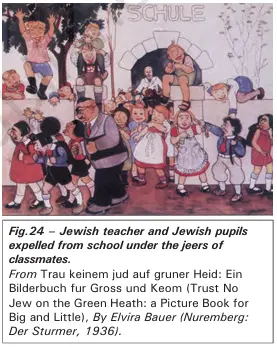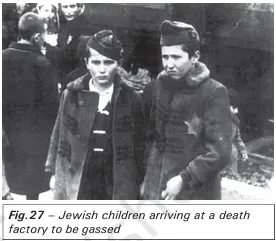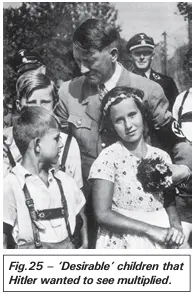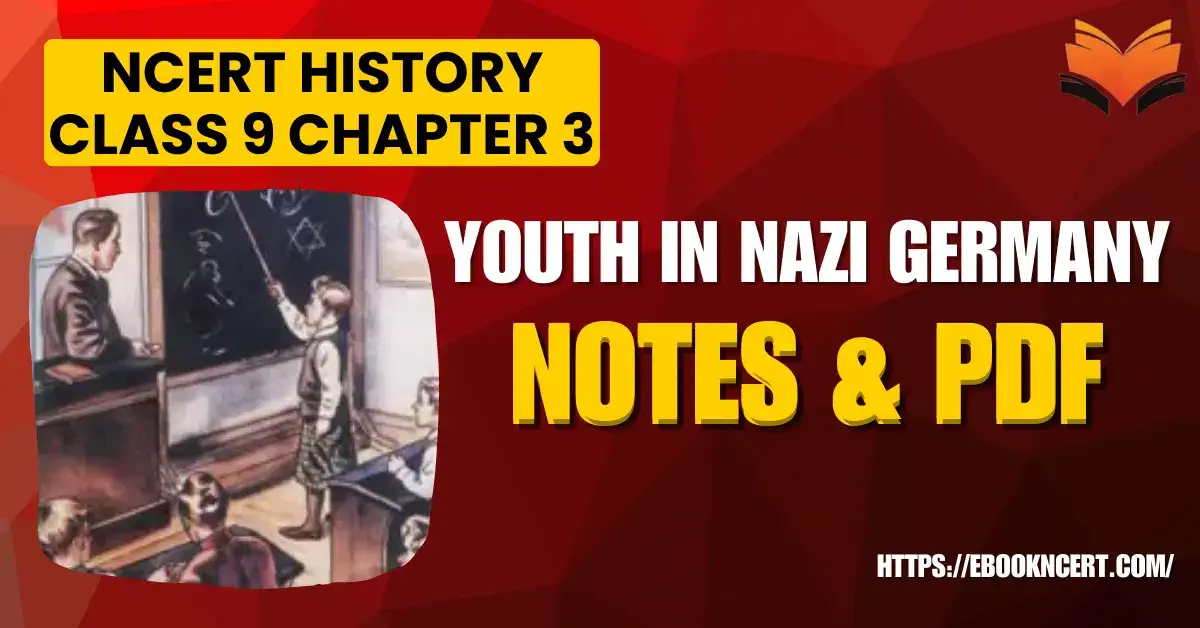Youth in Nazi Germany – Concept & Notes PDF
Topic & sub-topics covered: Youth in Nazi Germany and MCQs Questions: Nazism and the Rise of Hitler (All single detail notes are exam-oriented).
We have discussed in-depth and exam-oriented pointers that can be asked in the board exam of class 9th about the “Youth in Nazi Germany” from the NCERT History notes for class 9th chapter 3rd “Nazism and the Rise of Hitler“.
Download the NCERT History for Class 9th Chapter 3 Nazism and the Rise of Hitler Notes PDF
NCERT History for Class 9th Chapter 3_ Nazism and the Rise of Hitler Notes & MCQ’s Question-Answer
Have you ever wondered how a failed artist like Hitler ended up becoming the dictator of all Germany? Class 9 NCERT History Chapter 3 “Nazism and the Rise of Hitler” tells exactly that story. When I first read it, I was honestly shocked by how bad things got in Germany after the Treaty of Versailles – crushing debt, unemployment, and hopelessness everywhere. Imagine the 1930s: people struggling to survive, feeling betrayed and angry… and then comes one man who turns all that frustration to his advantage. These notes capture the key events, from Nazi propaganda to the persecution of Jews, in a way that’s quick to revise but still gives you the “feel” of that time.
Download the NCERT History Class 9 Chapter 3 Nazism and the Rise of Hitler Notes PDF to make your exam preparation clear and effective. These notes explain the historical background of Germany after World War I, the rise of Adolf Hitler, and the impact of Nazi ideology on society and politics. Download now and strengthen your understanding of one of the most significant and impactful chapters in modern world history for Class 9.
Youth in Nazi Germany

1. Hitler’s Aim Regarding Youth:
- Hitler believed a strong Nazi society could only be built by teaching children Nazi ideology.
- Control over children was exercised both inside and outside school.
2. Changes in Schools Under Nazism:

- All schools were ‘cleansed’ and ‘purified’:
a. Jewish teachers and those deemed politically unreliable were dismissed. - Segregation of children:
a. Germans and Jews could not sit together or play together. - Expulsion of ‘undesirable’ children:
a. Jews, physically handicapped, and Gypsies were removed from schools.
b. In the 1940s, many were sent to gas chambers.
3. Nazi Schooling for ‘Good German’ Children:
- Long ideological training was part of education.
- School textbooks were rewritten to promote Nazi ideas.
- Racial science introduced to justify Nazi racial beliefs.
- Anti-Jewish stereotypes taught even in mathematics.
- Children were taught to:
a. Be loyal and submissive.
b. Hate Jews.
c. Worship Hitler. - Sports aimed at promoting violence, aggression, and masculinity.
a. Hitler believed boxing made children strong, iron-hearted, and masculine.
4. Nazi Youth Organisations:
- Youth organisations trained German youth in National Socialist ideology.
- Jungvolk: Entry for boys at age 10.
- At 14 years: Boys joined Hitler Youth.
a. Training focused on worship of war, glorification of aggression, condemnation of democracy, and hatred towards Jews, communists, Gypsies, and others deemed undesirable. - At 18 years: After rigorous ideological and physical training, boys joined Labour Service.
a. This was followed by service in the armed forces or other Nazi organisations. - History of Nazi youth movement:
a. Youth League of the Nazis founded in 1922.
b. Renamed Hitler Youth in 1926.
c. All other youth organisations were systematically dissolved and banned to ensure complete Nazi control.
Source: C – Preliminary Nazi Training for Boys (Ages 6–10)

- Boys between 6 and 10 years old received basic training in Nazi ideology.
- At the end of training, boys took an oath of loyalty to Hitler:
a. Swore to devote all energies and strength to Adolf Hitler, referred to as the saviour of Germany.
b. Declared readiness to give up their life for Hitler.
c. Oath taken in the presence of the “blood banner” symbolising the Führer.
Source: D – Robert Ley’s Statement on Lifelong Nazi Control

- Robert Ley, Head of the German Labour Front, described a lifelong control process:
a. Starts at age 3: Children given a flag to wave to instil early loyalty.
b. Schooling followed by Hitler Youth membership.
c. Mandatory military service after youth organisation training.
d. Post-military: The German Labour Front took control of individuals. - This control continued until death, with no freedom to leave – whether a person liked it or not.
The Nazi Cult of Motherhood
1. Nazi Beliefs about Gender Roles:
- In Nazi Germany, children were taught that women were fundamentally different from men.
- The fight for equal rights between men and women (common in democratic movements) was considered wrong and harmful to society.
- Boys were taught to be aggressive, masculine, and steel-hearted.
- Girls were trained to become good mothers and raise pure-blooded Aryan children.
- Girls’ duties included:
a. Maintaining racial purity by avoiding Jews.
b. Managing the home.
c. Teaching children Nazi values.
d. Acting as bearers of Aryan culture and race.
2. Nazi Policy towards Mothers:
- In 1933, Hitler declared: “In my state the mother is the most important citizen.”
- Not all mothers were treated equally:
a. Mothers of racially undesirable children → punished.
b. Mothers of racially desirable children → rewarded.
3. Rewards for Aryan Mothers:
- Favoured treatment in hospitals.
- Concessions in shops, theatre tickets, and railway fares.
- Honour Cross awards for producing many children:
a. Bronze Cross → 4 children.
b. Silver Cross → 6 children.
c. Gold Cross → 8 or more children.
4. Punishment for Deviation from Nazi Code:
- Aryan women who broke Nazi rules were publicly condemned and punished.
- Contact with Jews, Poles, or Russians was treated as a “criminal offence”.
- Punishments included:
a. Public humiliation → shaved heads, blackened faces, placards reading “I have sullied the honour of the nation”.
b. Jail sentences.
c. Loss of civic honour, husbands, and families.
The Art of Propaganda

1. Nazi Use of Language in Propaganda:
- Nazis carefully chose deceptive and chilling terms to hide the reality of their crimes.
- Avoided words like “kill” or “murder” in official communication.
- Key euphemisms:
a. Special treatment → mass killings.
b. Final solution → genocide of Jews.
c. Euthanasia → killing of the disabled.
d. Selection & disinfections → extermination processes.
e. Evacuation → deportation to gas chambers. - Gas chambers were labelled “disinfection areas”, designed like bathrooms with fake showerheads.
2. Media and Communication in Nazi Propaganda:
- Media used strategically to gain support and spread Nazi ideology.
- Nazi ideas promoted through:
a. Visual images
b. Films
c. Radio
d. Posters
e. Catchy slogans
f. Leaflets - Posters depicted Nazi enemies as evil, mocked and abused.
3. Targeting of Political Opponents:
- Socialists and liberals were shown as weak and degenerate.
- Portrayed as malicious foreign agents threatening Germany.
4. Anti-Jewish Propaganda:
- Films made to create hatred for Jews – most infamous: The Eternal Jew.
- Orthodox Jews stereotyped as having flowing beards and kaftans.
- In reality, German Jews were highly assimilated and often indistinguishable from other Germans.
- Jews labelled as vermin, rats, and pests.
- Their movements compared to rodents.
5. Psychological Impact of Nazi Propaganda:
- Propaganda tapped into emotions, fostering hatred towards those labelled ‘undesirable’.
- Nazis worked to win support from all sections of society.
- Promoted the idea that only Nazis could solve Germany’s problems.
Source E & Source F
1. Hitler’s Views on Gender Roles:
- Hitler believed men and women had separate worlds and distinct roles.
- Men’s sphere: battlefield and courage.
- Women’s sphere: self-sacrifice, pain, and childbearing.
2. Motherhood as a ‘Battle’:
- Hitler compared childbirth to a battle for the existence of the German people.
- Every child was seen as a contribution to the survival of the race.
3. Women as Preservers of Race:
- Women considered the most stable element in preserving the folk (racial community).
- Believed women had an unerring sense of protecting the race from extinction.
4. Role of Women in Nazi Racial Ideology:
- Women’s children would be directly affected by racial suffering, so they had a vested role in protecting the race.
- Women were integrated into the racial struggle, as per ‘nature and providence’.
Some Important Dates:
- August 1, 1914 First World War begins.
- November 9, 1918 Germany capitulates, ending the war.
- November 9, 1918 Proclamation of the Weimar Republic.
- June 28, 1919 Treaty of Versailles.
- January 30, 1933 Hitler becomes Chancellor of Germany.
- September 1, 1939 Germany invades Poland. Beginning of the Second World War.
- June 22, 1941 Germany invades the USSR.
- June 23,1941 Mass murder of the Jews begins.
- December 8 1941 The United States joins Second World War.
- January 27,1945 Soviet troops liberate Auschwitz.
- May 8, 1945 Allied victory in Europe.
New words:
- Jungvolk – Nazi youth groups for children below 14 years of age.
Next & Previous Topics of NCERT/CBSE History Class 9 Chapter 3: Nazism and the Rise of Hitler
| Topics No. | Topics Name |
|---|---|
| 1 | Birth of the Weimar Republic |
| 2 | Hitler’s Rise to Power |
| 3 | The Nazi Worldview |
| 4 | Youth in Nazi Germany |
| 5 | Ordinary People and the Crimes Against Humanity |
MCQs on NCERT History Class 9 Chapter 3 Topic – Youth in Nazi Germany
Here are the top exam-oriented MCQ-type questions on “Youth in Nazi Germany” that you should prepare for your CBSE or state board exams:
Question 1. Who did Hitler believe was the most important group to shape a strong Nazi society?
a) Workers
b) Youth
c) Soldiers
d) Women
Answer: b) Youth
Question 2. What was the main aim of Nazi schooling?
a) To teach democratic values
b) To promote equality among all races
c) To instill Nazi ideology in children
d) To encourage free thinking
Answer: c) To instill Nazi ideology in children
Question 3. What was done to teachers who were Jews or considered ‘politically unreliable’ under Nazism?
a) They were promoted
b) They were dismissed
c) They were sent abroad
d) They were given different subjects
Answer: b) They were dismissed
Question 4. Which groups of children were thrown out of schools under Nazi rule?
a) Only Jews
b) Jews, the physically handicapped, and Gypsies
c) Only the physically handicapped
d) Only political opponents
Answer: b) Jews, the physically handicapped, and Gypsies
Question 5. What was introduced in Nazi school textbooks to justify their racial ideas?
a) Social sciences
b) Racial science
c) Political science
d) Economic theory
Answer: b) Racial science
Question 6. Which youth organisation did ten-year-old boys have to join?
a) Hitler Youth
b) Jungvolk
c) Labour Service
d) German Scouts
Answer: b) Jungvolk
Question 7. At what age did boys have to join the Hitler Youth?
a) 10 years
b) 12 years
c) 14 years
d) 18 years
Answer: c) 14 years
Question 8. Which year was the Youth League of the Nazis founded?
a) 1919
b) 1922
c) 1926
d) 1933
Answer: b) 1922
Question 9. What was the Hitler Youth renamed from in 1926?
a) Jungvolk
b) Youth League of the Nazis
c) Labour Service Youth
d) Aryan Youth Club
Answer: b) Youth League of the Nazis
Question 10. What type of training did Hitler believe boxing could provide to children?
a) Intelligence and creativity
b) Loyalty and discipline
c) Iron-heartedness, strength, and masculinity
d) Teamwork and cooperation
Answer: c) Iron-heartedness, strength, and masculinity
Question 11. In Nazi ideology, what role were girls encouraged to fulfil?
a) Become soldiers
b) Become politicians
c) Become good mothers and bear pure-blooded Aryan children
d) Work in factories
Answer: c) Become good mothers and bear pure-blooded Aryan children
Question 12. How were women rewarded for producing racially desirable children?
a) Gold medals and free houses
b) Favoured treatment in hospitals, concessions in shops, and theatre and railway discounts
c) Free education for children
d) Voting rights
Answer: b) Favoured treatment in hospitals, concessions in shops, and theatre and railway discounts
Question 13. What was the Honour Cross awarded for?
a) Military bravery
b) Producing multiple children
c) Academic excellence
d) Political loyalty
Answer: b) Producing multiple children
Question 14. How many children were required for a gold Honour Cross?
a) Four or more
b) Six or more
c) Eight or more
d) Ten or more
Answer: c) Eight or more
Question 15. Which groups were women forbidden to maintain contact with under Nazi laws?
a) Jews, Poles, and Russians
b) Italians and French
c) British and Americans
d) Chinese and Japanese
Answer: a) Jews, Poles, and Russians
Question 16. What term did Nazis use instead of ‘mass killing’?
a) Final solution
b) Victory action
c) Special mission
d) Purification program
Answer: a) Final solution
Question 17. In Nazi propaganda, what were Jews compared to?
a) Lions
b) Rodents and pests
c) Wolves
d) Snakes
Answer: b) Rodents and pests
Question 18. What was the most infamous Nazi propaganda film against Jews?
a) The German Victory
b) The Eternal Jew
c) Aryan Glory
d) The Final War
Answer: b) The Eternal Jew
Question 19. What did the Nazis label gas chambers to mislead victims?
a) Rest areas
b) Disinfection-areas
c) Bathing zones
d) Purification halls
Answer: b) Disinfection-areas
Question 20. When did Germany invade Poland, starting World War II?
a) June 28, 1919
b) September 1, 1939
c) June 22, 1941
d) December 8, 1941
Answer: b) September 1, 1939

